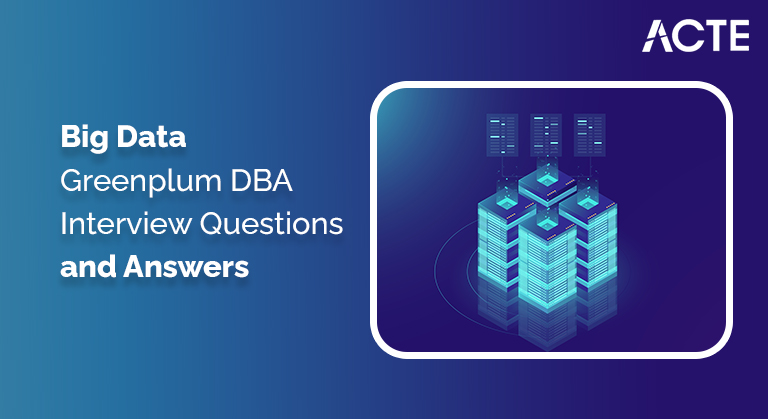
Big Data Greenplum DBA Interview Questions And Answers [ To Get Hired ]
Last updated on 11th Apr 2024, Popular Course
It is necessary to have a thorough understanding of data warehousing ideas, be proficient in SQL, and be familiar with Teradata tools and utilities in order to prepare for Teradata interviews. Applicants should be prepared to go over Teradata architecture, query optimisation strategies, database design concepts, and real-world problem-solving scenarios. To impress prospective employers and land a job in Teradata development, administration, or analytics, you need to have strong communication skills, critical thinking abilities, and a love for using data for business insights.
1. How does Greenplum’s architecture differ from that of a conventional RDBMS?
Ans:
Unlike standard RDBMS, which usually employs SMP (Symmetric Multi-Processing) architecture, Greenplum’s architecture is characterized by its MPP (Massively Parallel Processing) design. Greenplum can run numerous queries or portions of a query in parallel across separate nodes because of MPP’s independent operating systems, memory, and disk storage on each server or node. This greatly improves query performance and data throughput for huge datasets.
2. How do you optimize queries in Greenplum?
Ans:
Greenplum query optimization involves multiple strategies:
- Selecting the distribution key to minimize data skew and optimize join operations.
- Reducing the amount of data scanned through partitioning to improve query performance.
- Creating relevant indexes (though less frequently used in MPP databases).
- Managing workloads with resource queues.
The optimizer’s analysis and statistics gathering on tables aid in selecting the optimal query plan.
3. Explain the process of data distribution in Greenplum and its impact on performance.
Ans:
When a table is created in Greenplum, data distribution is mostly managed by hash or random distribution. The distribution key selection has a significant impact on the efficiency of joint operations and the balance of data among nodes, hence lowering skew. To save network traffic during joins, the distribution key should ideally guarantee that related data is located in the same segment. Erroneous distribution may result in data skew, which can overload certain nodes and impair query performance.
4. What are some common maintenance tasks for a Greenplum DBA?
Ans:
A Greenplum DBA’s routine maintenance responsibilities include managing user roles and permissions to ensure security, configuring and overseeing backup procedures, planning for data growth to ensure the cluster scales effectively, and periodically running the VACUUM and ANALYZE commands to recover storage and update statistics for the optimizer.Furthermore, ensuring data availability and integrity requires regularly scanning for failed segments and retrieving them as needed
5. How does Greenplum handle backups and restores, and what options are available?
Ans:
- Greenplum manages backups using the versatile and effective backup and restore capabilities offered by the up backup and restore tools.
- DBAs have the option of backing up individual databases or the entire cluster, performing full or incremental backups, and storing backup files on-site or in the cloud.
- These technologies are intended to reduce downtime and guarantee data integrity during backup operations.
- DBAs can also utilize the up mirror tool to manage mirror segments and guarantee data redundancy for disaster recovery.
6. Describe a situation in which you had to solve a performance issue in Greenplum. What steps did you take?
Ans:
Troubleshooting a performance problem begins with identifying slow-running queries using system views like pg_stat_activity. Once a problematic query is identified, explain plans are used to understand the query execution plan and identify bottlenecks, such as costly operations or data skew. Next, review the distribution and partitioning strategy of the involved tables and consider collecting fresh statistics with ANALYZE if they are outdated. If necessary, we adjust resource queues to manage workloads more effectively or propose query or schema modifications to improve performance.
7. Discuss how Greenplum manages data security and compliance.
Ans:
- Greenplum offers strong data security and compliance features. These features include role-based access control, data encryption both in transit and at rest, and an interface with business authentication systems like Kerberos and LDAP.
- Furthermore, auditing features enable the monitoring of all database operations, assisting enterprises in adhering to compliance standards for data access and modifications. Regular security audits and updates are also essential to handling any new risks.
8. What is the Greenplum Database?
Ans:
- Greenplum Database is an advanced, open-source MPP (Massively Parallel Processing) data warehouse platform that supports large-scale analytics on large volumes of data.
- It is built on PostgreSQL and is designed to provide high performance, fault tolerance, and easy scalability, enabling complex queries and analytics operations across petabytes of data.
- Greenplum’s architecture allows it to distribute data and query processing across multiple nodes, making it highly effective for data warehousing and big data analytics.
9. How does Greenplum achieve high performance for large-scale data analytics?
Ans:
Greenplum’s MPP architecture, which distributes data and query execution across numerous servers or nodes, enables it to operate at higher performance levels. Each node’s simultaneous work on its share of the data speeds up analytics and data processing considerably. Petabyte-scale data workloads may be handled well with Greenplum thanks to its utilization of partitioning, parallel data loading, and sophisticated query optimization algorithms, among other performance-enhancing measures.
Ans:
Ans:
Ans:
Ans:
Ans:
Ans:
Ans:
Ans:
Ans:
Ans:
Ans:
Ans:
Ans:
Ans:
Ans:
Ans:
Ans:
Ans:
Ans:
Ans:
Ans:
Ans:
Ans:
Ans:
Ans:
Ans:

